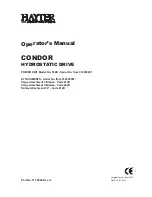
Scans by Artekmedia
=>
2011
SE
C
ll0N
·
4
CIRCUIT DESCRIPTION
This
s
e
c
t
i
o
n
describes the fu
n
c
t
i
o
ns
o f
m
a
j
o
r
c i rcuit
elements
and
thei r
relationships
to one another
as
shown
in
figure 4-1 ,
fu nctional
block
diagram. The
fol
lowing
sections in
this
manua l
provide
more
detailed
i n formation
for
maintaining
the
instrument.
As
shown
i n
fi
g
u
r
e 4-1 ,
the
VCG
(Voltage
Co
n
t
r
o
l
of
Gene
r
a
t
or)
sums
v
o
l
t
ag
e
i nputs
from
the
frequency
d
ia
l
and
the
VCG I N
connector.
This
sum
voltage
con
t rols
the
magni tude
of
a
complementary
cu rrent
sou rce
and
cu rrent
sink .
This
cu rrent
varies
l
i
n
e
a
r
i
l
y
f rom approximately
2 mA
to
2
pA over a
1 000:1 (4.0
to
.004) range
or
logarithmically
from
approximately
2
ma
to 0.2 �
over
a 1 0,000:1
(4.0
to
. 0004) range
of
each
frequency
mu ltiplier.
T
h
e
.
V
C
G
also
controls
the
trigger
baseline compensation
c i rcuit,
which consists
of another
c u rrent
si nk
at twice the
current
magn itude .
The diode
gate, controlled by the comparator
output,
connects
either
the
c u rrent
source
or
the current
sink
to
the
timing
capacitor selected
by
the frequency
m u l tiplier.
When
the current
so
u
r
c
e
is
switched
in, the
c h a rge
on
the timing.
capaci tor
will
rise
Iinea rily,
pro
ducing
the
positlve-going
triangle
slope. Likewise,
the
c u rrent
sink p
rodu
c
e
s
the negative-going
triang le
slope
.
The
t
r
i
a
n
g
l
e
amplifier
is
a
unity
gain
ampl ifie r
whose
output
is
fed
to
the
compa rator and
to
the
output
c i r
cu its. The
c
o
m
p
a
r
a
t
o
r
operates
as
a
wi ndow det
ec
tor
with
li mit
points
set
to
the
t
r
i
a
n
g
l
e
peaks.
The
±
2V
output is
sent
back to the diode gate and
to
the output
c
i
r
cu
it
s
.
When
the
output
is
+
2V, the
·
triangle
is
positive-going until
the
+
1 .25V limit
is
reached and
the
comparator output switches to
-
2V
.
When
the
output
is
-
2V, the
t riangle
is negative-going
unti l
the
-
, .25V
l imit
Is
reac hed
and the comparator
output
switches back to
+
2V,
repeating
the
p
roce
s
s
.
In this
manner,
the basic function
gene rator
loop, the
bold
path in
figure
4-1 , produces simultaneous generation
of
triangle
and
square
waves at
the
same
frequency.
The output frequency
is
determined by the
magnitude
of
the
t
i
m
i
n
g
capacitor
selected by
the frequency
mu ltiplier
swi tches
and by
the magn itude
of
the
cur
rents
s
u
p
p
l
i
e
d
to
and
removed
from it. Since
the
cu r
rents
a re
lineari ly
p
r
op
o
rt
i
o
n
a
l
to
the
sum
of the
VCG
inputs,
so
wi
l
l
be
the
outpu t
f
r
eq
u
ency
.
To extend the lower frequency
capability
of the
generator,
a
capac itance
multipl ier
c i rcuit
divides
VCG
currents by 1 0
(effectively
multiplyi ng
the
timing
capac itor
by 1 0) for each of the
lower
3
multiplie r
r
anges
.
The TIL
square from
the comparator
i s
buffered and
sent to
the
SYNC OUT TIL connector. The other side
is sent
to
the trigger
flip-flop
and to a
leve l
sh ifte r to
produce
the
±
2V
bipola r
squa re
for the
diode
gate
and
the
square shaper
circuits.
The
.
sq
uare shaper
conve rts
the sauare i
n
t
o
a
c u rrent
signal and
appl ies
it
to the
1..;
FU NCTION
switch,
The
buffe red
triangle is
applied
to
the
"
"
FUNCTION switch and
to
the
sine
conve rte r
input. The
si ne
conve rter,
using the
non l i nea r c haracteristics of
its
d iodes,
conve rts
the
tria ng le
i nto
a
sinusoida l
current
for the
rv
FUNC
TION
switc h .
The
selected function
i s
s
e
n
t to the preamplifier,
w
h
e
r
e
it
is
inverted
and
buffered. The
preampl ifier
out
put
goes
to the
output
a
mpl
i
f
i
e
r
through
the
AMPLITUDE
control
where
it
is summed with offset
voltage from the DC OFFSET
control. He
r
e
,
waveform
and offset are
inve rted
and ampl ified
to
a
±
1 0V
peak
signal
w
h
i
ch can dri
v
e
a
50n termination from a 500
sou rce
i mpedance .
The output
amplifier
d rives
the
500 OUT
HI
connector
and
a
resistor divider
produc
ing
the 500 OUT LO output.
Noncontinuous
modes of operation
(t rigger
and
gate)
resu lt from
a
l
l
ow
in
g
or
preventing
the VCG
c u rrent
sou rce
from charging the
tim ing
capaCitor.
W
h
en
-
eve
r
the
trigger
flip-flop
output
is low,
each
of the two
trig
ger diodes
conduct
a
cu r rent
I,
sou rcing
21
to
the
baseline
compe nsation
ci rcuit.
This
removes
the
cur
re
n
t
I from the
VCG
current source and forces
a
OV
basel i ne
at
the triangle amplifier
input.
4-'
Summary of Contents for 188
Page 2: ...Verso Filler Page ...
Page 3: ...MODEL 188 4 MHz SWEEPI FUNCTION GENERATOR ...
Page 4: ...Verso Filler Page z z ...
Page 8: ...Verso Filler Page z z ...
Page 10: ...Verso Filler Page z z ...
Page 16: ...Verso Filler Page z z ...
















































